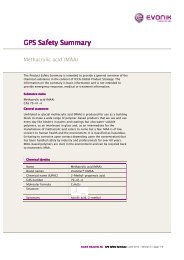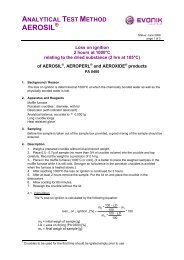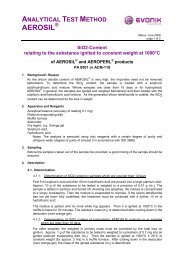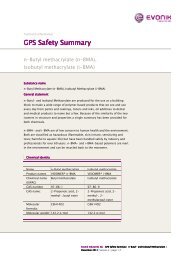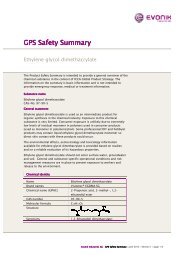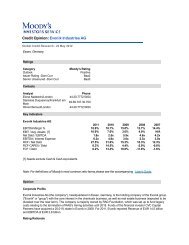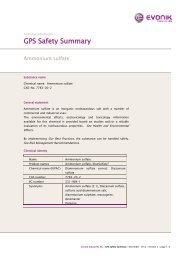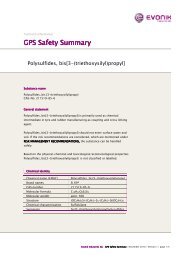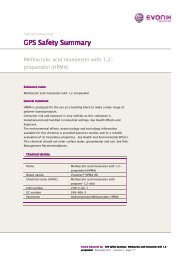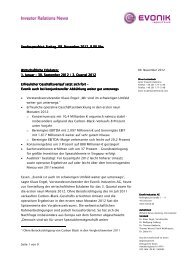trimethoxyethoxyvinylsilane GPS Safety Summary - Evonik ...
trimethoxyethoxyvinylsilane GPS Safety Summary - Evonik ...
trimethoxyethoxyvinylsilane GPS Safety Summary - Evonik ...
Create successful ePaper yourself
Turn your PDF publications into a flip-book with our unique Google optimized e-Paper software.
Exposure<br />
Human / Environment<br />
There is no exposure to humans from Trimethoxyethoxyvinylsilane via the<br />
environment, as the substance is highly reactive and, thus, immediately<br />
hydrolyzes. Manufacturing occurs under controlled conditions, with releases<br />
to air and waste water according to the existing legal and regional<br />
permissions. Releases to the environment during use and handling are<br />
limited by use of appropriate measures as mentioned in the <strong>Safety</strong> Data<br />
Sheet and described under Risk Management Recommendations. Due to the<br />
reactive nature of Trimethoxyethoxyvinylsilane when in contact with water, or<br />
indeed with silanols, under the conditions used to prepare silicone polymers<br />
and resins, it can be assumed that they are completely consumed in the<br />
hydrolysis/condensation process,<br />
In those cases where Trimethoxyethoxyvinylsilane in sealants is used in<br />
professional applications, the Silane has invariably hydrolyzed and<br />
condensed to form Siloxane oligomers and polymers and there is no<br />
exposure from the end product.<br />
Risk management recommendations<br />
Description<br />
General measures<br />
Specific Human Health risk<br />
management measures<br />
Specific Environment risk<br />
management measures<br />
Production and on site<br />
(i) Procedural and<br />
(i) Local Exhaust ventilation (LEV)<br />
(i) Use of air emission<br />
use (site specific)<br />
technological control using<br />
(ii) Personal Protective Equipment<br />
abatement equipments such<br />
Best Available Technique<br />
(PPE): Fluorinated or nitrile rubber<br />
as incinerators and scrubbers<br />
(BAT)<br />
gloves/gauntlets and protective<br />
(ii) Treatment of effluent in<br />
clothing<br />
biological waste water<br />
(iii) Specific workers’ training<br />
treatment plant<br />
(iii) Incineration of waste<br />
Intermediate, use as<br />
(i) Procedural and<br />
(i) Local Exhaust ventilation (LEV)<br />
(i) Treatment of effluent in<br />
monomer, non-metal<br />
technological control using<br />
(ii) Personal Protective Equipment<br />
waste water treatment plant<br />
surface treatment, non-<br />
Best Available Technique<br />
(PPE): Fluorinated or nitrile rubber<br />
(WWTP)<br />
aqueous polymer<br />
(BAT)<br />
gloves/ gauntlets and protective<br />
preparation. Use in<br />
clothing;<br />
rubber and plastics<br />
Suitable respiratory<br />
protective equipment should<br />
be worn if duration of<br />
exposure is greater than 15 min<br />
(iii) Workers’ training<br />
Industrial use of sealants<br />
(i) Procedural and<br />
(i) Butyl, nitrile, or neoprene<br />
(i) Treatment of effluent in<br />
technological control using<br />
gloves / gauntlets and protective<br />
waste water treatment plant<br />
Best Available Technique<br />
clothing;<br />
(WWTP).<br />
(BAT)<br />
(ii) Workers’ training<br />
Professional use of<br />
N/A<br />
(i) maximum product<br />
(i) Standard municipal WWTP<br />
sealants<br />
concentration of 0.4%; (ii) Butyl,<br />
nitrile, or neoprene gloves<br />
recommended<br />
<strong>Evonik</strong> Industries I<br />
AG | <strong>GPS</strong> <strong>Safety</strong> <strong>Summary</strong> | November 2010 | Version 1 | page 4/6




